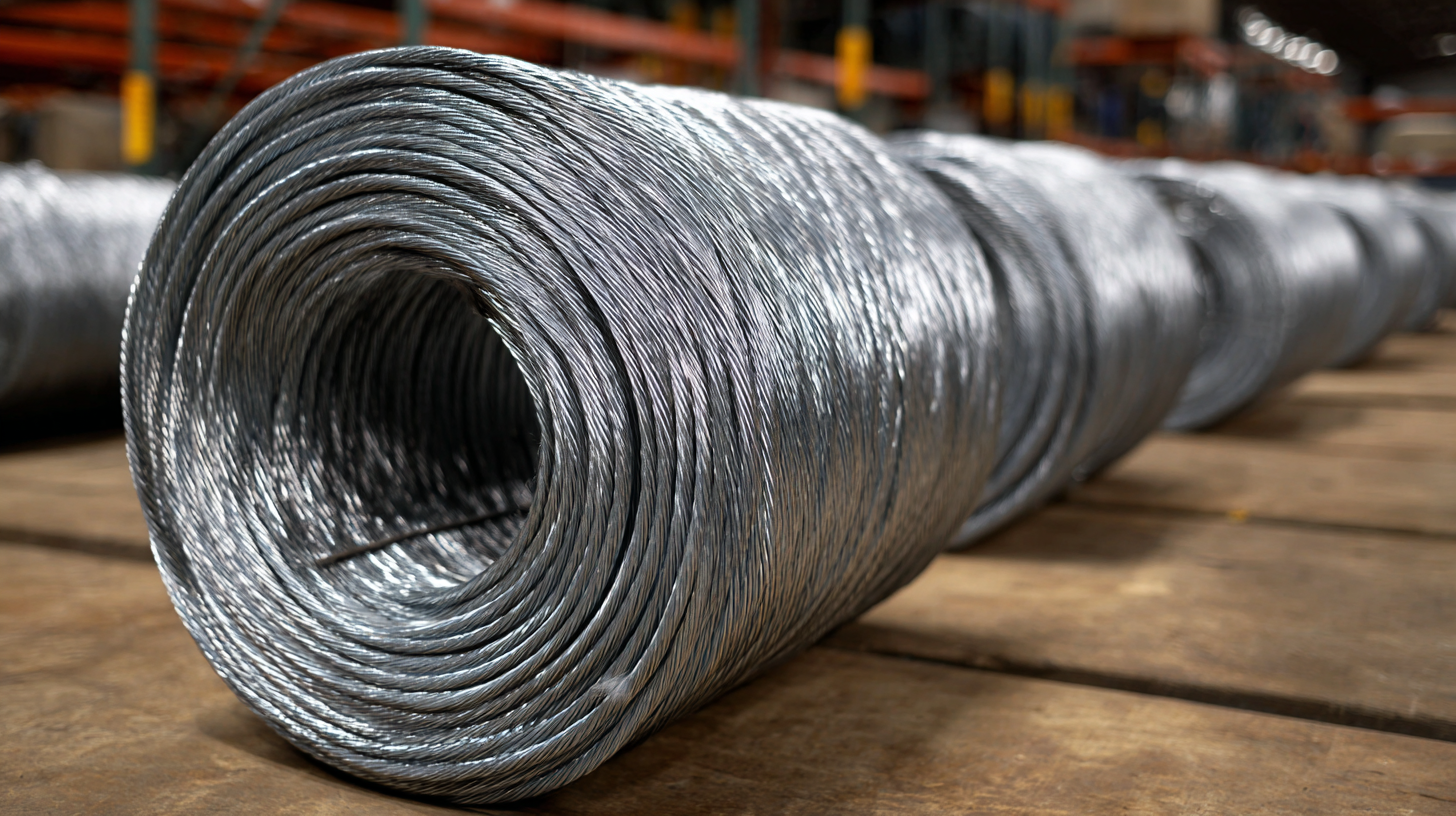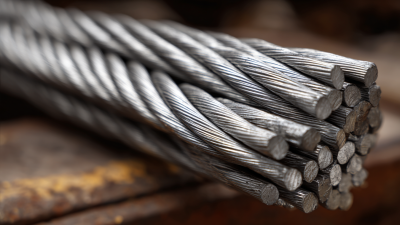
-
Home
-
Products
-
PVC Cable Material
-
Low Smoke Zero Halogen Cable Material
-
Cable material
-
Optical fiber cable
-
-
About Us
-
VR
-
News
-
Blog
-
Contact Us
Leave Your Message

When embarking on a construction or engineering project, selecting the appropriate materials is crucial for ensuring structural integrity and longevity. Among the various options available, **Galvanized Steel Wire Strand** stands out for its durability and corrosion resistance, making it an ideal choice for outdoor applications. According to a report from the International Steel Association, the global demand for galvanized steel products has surged by approximately 5% annually over the past five years, driven by its versatility in various sectors, including construction, mining, and automotive industries. As projects increasingly prioritize sustainability and performance, the right choice of galvanized wire strand can significantly impact not only the project's success but also its overall lifecycle and maintenance costs. Understanding the different types of galvanized steel wire strands, along with their specific attributes and applications, is essential for making informed decisions that align with both project requirements and industry standards.

When selecting galvanized steel wire strand for construction projects, several critical factors must be considered to ensure optimal performance and durability. First and foremost, understanding the project's specific requirements is essential. Projects may demand different tensile strengths or load capacities, depending on their intended use. For instance, a structure that requires robust support systems will benefit from a higher gauge wire strand, which can endure significant stress without compromising safety.
Another vital aspect to examine is the environmental factors that the galvanized wire will be exposed to. Corrosion resistance is a key advantage of galvanized steel, but different environments can impact its longevity. For projects in coastal or high-humidity areas, selecting wire strands with enhanced corrosion protection may be necessary to prolong the lifespan of the materials. Additionally, consider the coating thickness, as this plays a crucial role in the wire's resistance to environmental wear and tear.
Lastly, compatibility with other construction materials is essential to ensure a cohesive build. The galvanized steel wire strand should not only meet the mechanical requirements but also work seamlessly with other components, such as anchors or ties. Discussing these factors with suppliers or engineers can provide insights into the best options available, ensuring that the final selection aligns with project specifications and structural integrity.

When selecting the right galvanized steel wire strand for your project, understanding the different types available is paramount. Galvanized steel wire is typically categorized into two main types: electro-galvanized and hot-dipped galvanized. Electro-galvanized wire is coated with a thin layer of zinc through an electroplating process, providing good corrosion resistance in less demanding environments. It's commonly used in applications such as fencing and low-stress wire installations. According to a 2022 industry report by the Steel Wire Association, electro-galvanized wires account for approximately 25% of the galvanized wire market.
On the other hand, hot-dipped galvanized wire offers superior protection due to the thicker zinc coating, making it suitable for harsher environments, such as coastal regions or industrial settings. This type of wire strand not only enhances durability but also significantly extends the lifespan of the product. Recent data from the Global Steel Wire Market Analysis suggests that hot-dipped galvanized wire comprises around 60% of the market, reflecting its widespread use in construction, agriculture, and utility applications. The choice between these wire types ultimately hinges on the specific environmental conditions and mechanical stresses anticipated for your project.
| Wire Diameter (mm) | Breaking Load (kN) | Typical Uses | Corrosion Resistance | Coating Thickness (μm) |
|---|---|---|---|---|
| 3 | 12.7 | Fencing, Tensioning | High | 50 |
| 5 | 30.0 | Construction, Aerial Lifting | Moderate | 65 |
| 7 | 56.0 | Bridges, Heavy Duty Applications | Very High | 80 |
| 10 | 100.0 | Marine Structures, Telecommunications | Moderate | 100 |
When selecting the appropriate galvanized steel wire strand for your project, understanding the load-bearing capacities is essential. Wire strands are classified based on their construction, size, and tensile strength, which directly impacts performance under load. According to the Wire Rope Technical Board, common specifications for wire strands include ASTM A 475, which focuses on galvanized steel wire strand's minimum breaking strength, ensuring that it meets specific safety standards. For example, a 7x19 strand construction with a diameter of 3/16 inches can have a minimum breaking strength of around 1,470 lbs, making it suitable for moderate load-bearing applications.
Moreover, factors such as environmental conditions and fatigue resistance play a significant role in determining the right wire strand for various applications. A report from the International Organization for Standardization (ISO) highlights that corrosion resistance and durability are critical for projects exposed to harsh conditions. Selecting a wire strand with a higher zinc coating weight can enhance its longevity, making it more suitable for outdoor installations. Understanding the specifications and performance metrics of galvanized steel wire strands allows engineers and project managers to make informed decisions that ensure both safety and reliability in their projects.
When selecting galvanized steel wire strands for your project, understanding the corrosion resistance ratings is crucial. Galvanization involves the application of a zinc coating to steel, which protects it from rust and corrosion. There are different levels of galvanization, typically categorized as hot-dipped, electro-galvanized, and mechanical galvanization, each offering varying degrees of protection. For projects exposed to harsh environments, hot-dipped galvanization is often preferred due to its thicker zinc layer that enhances durability and longevity.
It's essential to assess the specific conditions your project will face, such as moisture, salt exposure, or chemical contact. For instance, an outdoor construction project near a coastal area may require a high level of galvanization to withstand saline conditions. On the other hand, projects in less demanding environments might succeed with standard electro-galvanized strands. Ultimately, selecting the right galvanization level ensures the structural integrity of your project, reduces maintenance costs, and extends the life of the materials used.
When evaluating the economic impact of various galvanized steel wire options, a thorough cost-benefit analysis is essential for making an informed decision. Different grades and coatings of galvanized steel wire can significantly vary in price, performance, and longevity. For instance, while higher grade wires may come at an elevated initial cost, their durability and resistance to corrosion can lead to lower maintenance and replacement expenses over time. This consideration is crucial when planning long-term projects where sustainability and cost-effectiveness are paramount.
Furthermore, the intended application of the galvanized steel wire should guide the choice. For heavy-duty uses, investing in a premium galvanized steel wire might yield better overall value, providing enhanced safety and reliability. In contrast, for less demanding applications, a more economical option could suffice without compromising on performance. By evaluating the potential risks and costs associated with each option, project managers can align their budget with the expected lifespan and functionality of the materials, ensuring that their choice is both economically sound and practical for their specific needs.






